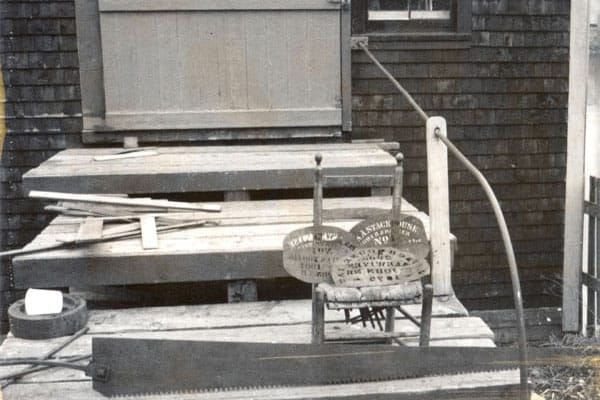A weathered building evokes foggy memories of a bustling life and bygone livelihood.
Once, in the calm of thickly blanketed-or socked-in-Saint John, NB, mornings, men in salmon skiffs pierced the stillness by blowing their hand-held tin foghorns, the only way to make their presence known amid the sailing-lane of the harbour fishery. Such calls were no doubt heard all the way to home base-a string of bustling fish houses where the St. John River enters the inner harbour. At the time, the local fishing industry was so robust that it provided shad and salmon to markets as distant as the West Indies and South America.
One of those tin horns now belongs to the New Brunswick Museum's permanent collection. It has oxidized some during the long years since its daily use aboard the skiff of 19th-century fisherman James A. Stackhouse. Except for a single remaining building, Stackhouse's foghorn and other apparatus-a pike pole, dipping nets, tar pots and barrel stencils-are virtually all that's left of an industry and a way of life nearly forgotten. These symbols defined an era; now, they are tucked away in the museum's collection and exhibited periodically, somehow diminished when seen out of their proper context-the two-and-a-half-storey fish house Stackhouse built in 1861, which now clings to survival behind a home on Riverview Drive in West Saint John.

Riverview Drive is a winding, hard-to-find dead-end road, one of four former Main Streets in areas of Saint John that-during an era of less casual mobility-were communities unto themselves. According to Gary Hughes, the museum's curator of history and technology, Saint John was then a community of communities, each of which had strong feelings of independence and importance. West Saint John at that time was named Carleton, and was a mirror image of the east side of the city: each had not only its own Main Street, but also King Street, Germain Street, King Square and Queen Square.
A career-long advocate of heritage preservation, Hughes holds the Stackhouse fish house in high regard, referring to it as a recently working shed that is as historically rare and important as those found in Lunenburg, NS-a town whose working seaside architecture has earned it a UNESCO World Heritage Site designation.
Fish were salted, stored and sometimes smoked in Stackhouse's building, a wood-framed structure with large doors at the front and rear. From the front door, export barrels were rolled out to a waiting wagon, identified on their tops with stencilled type: "J. Stackhouse No. 1, 200 lbs. St. John NB 1873." Fifty years later, the company was still going strong, and still marking and shipping their products in those hefty barrels: "Jas. A. Stackhouse, Curer and Packer, No. 1, 200 lbs., 1923."
The rear door opens directly onto the St. John River-one false step could be a wet one-allowing for easy shifting of the fish from the skiff to the building's interior. A modest but all-important weather vane turns overhead. The building's original timbers can still be seen inside, including floorboards that are 16 inches wide-as broad as those used for ship's hulls. It was on those sturdy floors that Stackhouse would prepare for his harvest by dipping cotton twine netting in murky, sticky tar pots, the common method of the day for protecting nets from deterioration.
Against the modern backdrop of industrialized Saint John, it's hard to believe that a thriving fishery was once a critical economic pillar here, surpassed in value only by shipbuilding. Long before the pulp mill industry, fishing was, like shipbuilding, part of what mattered most to the community. Saint John Harbour produced a thriving fishery for two reasons: prolific sea life around the mass of nutrients brought by Fundy's huge tides, and the migration of fish to and from the largest freshwater ecosystem in Atlantic Canada-the mighty St. John, extending more than 400 kilometres to tributaries flowing from the Appalachian range.
With the collapse of salmon stocks, however, came change: the commercial salmon fishery that propelled the Stackhouse enterprise and its neighbours was shut down in 1972; in 1985 all commercial netting was banned.
Now, the city is rapidly transitioning its downtown toward heritage revival, with improved pedestrian waterfront access, while the city's Harbour Passage has emerged as a model of harbourfront design. But there are no plans for the last fish house, which is threatened by the elements. It looks wobbly and vulnerable, as though prepared to cast itself into the river in defeat. If Gary Hughes had his way, the structure would be saved-lock, stock and barrels-a feat requiring official heritage designation, investment and the co-operation of the current property owners, as well as an intervener with the vision and the passion to salvage a piece of history.
In a town that understands good, old-fashioned hard work, the Saint John fish house is a standing symbol of that heritage-a reminder of when James A. Stackhouse and his contemporaries cast off from their fish houses early each morning to till the waters for their families' bread, with foghorns, pike poles and nets close at hand.
